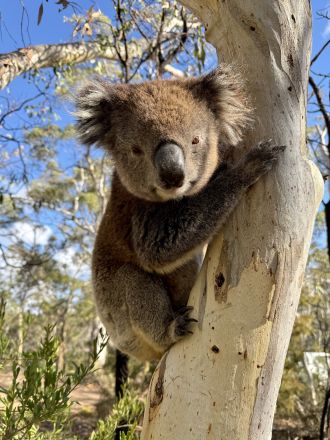Media release
From:
Island haven for threatened koalas is a genetic ‘trap’ without intervention
Kangaroo Island in South Australia is home to a large, mostly disease-free koala population which, at first glance, looks like a conservation success story.
However, new research from Flinders University shows that because the population started small, it carries a genetic legacy that may make it harder to survive future threats.
Using whole-genome sequencing, researchers compared Kangaroo Island koalas with mainland populations in Victoria and Queensland.
Despite their relatively high abundance on Kangaroo Island, these koalas have much lower genetic diversity and are much more inbred than koalas on the mainland.
The problem stems from their history. In the 1920s, fewer than two dozen koalas were moved from Victoria to Kangaroo Island to save the species after hunting and habitat loss nearly wiped them out. Those original koalas came from a population that was already small and genetically limited.
Today, koalas along Australia’s east coast are officially listed as endangered, with populations becoming smaller and more isolated due to forest clearing, bushfires, diseases, and road development.
In contrast, the koalas on Kangaroo Island have become a symbol of hope for the species, in spite of major bushfires which razed more than half of the island in 2019-20.
Lead author Dr Katie Gates says: “Kangaroo Island koalas are a successful conservation story in terms of population size. But their genetic health tells a different story. Their limited diversity and high inbreeding means they might struggle to adapt to future threats like disease or climate change.”
The Flinders University researchers found that Kangaroo Island koalas have many more, and longer, stretches of identical DNA inherited from both parents. Scientists call these stretches runs of homozygosity, and they are a hallmark of inbreeding.
The team also found that potentially harmful genetic variants were more often present in a double dose on Kangaroo Island koalas, increasing the chance that those variants are expressed in new offspring.
This pattern increases the risk of fertility and other developmental problems, consistent with several abnormalities found in captured koalas.
While the population has so far mostly resisted infectious diseases like chlamydia and koala retrovirus, its reduced genetic toolkit could leave it vulnerable to future outbreaks.
The researchers recommend proactive conservation management, including ‘genetic rescue’ – or the careful introduction of new koalas from genetically diverse mainland populations.
Senior author Professor Luciano Beheregaray says: “Kangaroo Island has the potential to remain an important conservation refuge for koalas. But without genetic management, this ‘ark’ could become a trap. Our work highlights the importance of ongoing genomic monitoring for species managed in isolation.”
The findings also carry a broader message for wildlife conservation: while islands and fenced reserves can provide immediate protection, they must be paired with strategies to bolster genetic diversity if they are to remain true havens for threatened species.
The article, Conservation arks: genomic erosion and inbreeding in an abundant island population of koalas (2025) by K Gates, J Sandoval-Castillo, JE Beaman, K Burke da Silva, R Saltré, K Belov, CJ Hogg, CJA Bradshaw and LB Beheregaray, has been published in Molecular Ecology DOI: 10.1111/mec.70097.
Acknowledgements: This work was supported by Australian Research Council, LP210100450.
The authors acknowledge the Traditional Owners of Country (mainly Ngarrindjeri, Naurungga, Kaurna, and Peramangk in South Australia) throughout the regions where we collected data and did the analyses. This work received logistic support from Flinders University and the University of Sydney. Data was collected in accordance with relevant guidelines and regulations of Australia and under Flinders University Animal Ethical Approval AEC BIOL5591-15.
Multimedia





 Australia; NSW; SA
Australia; NSW; SA


